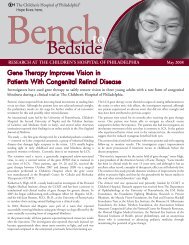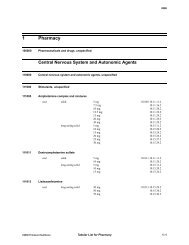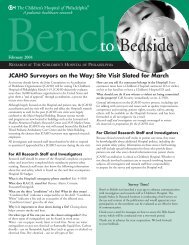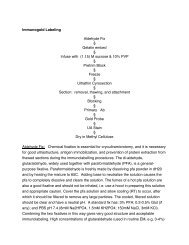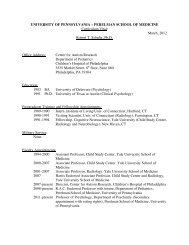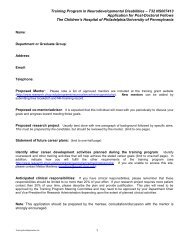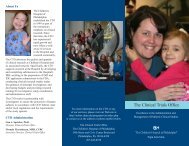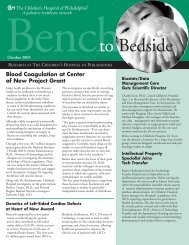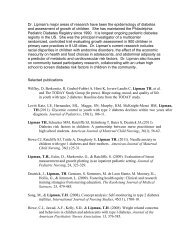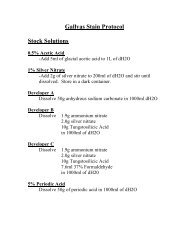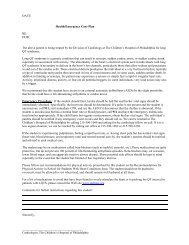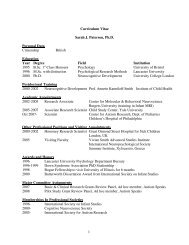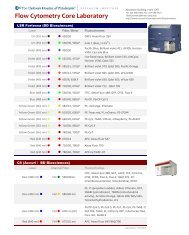Consent Template: Combined HIPAA - The Children's Hospital of ...
Consent Template: Combined HIPAA - The Children's Hospital of ...
Consent Template: Combined HIPAA - The Children's Hospital of ...
Create successful ePaper yourself
Turn your PDF publications into a flip-book with our unique Google optimized e-Paper software.
Study Procedures:<br />
We will ask you for your contact information (address, phone numbers and email<br />
address) and that <strong>of</strong> two other friends so that we may be sure we can keep in touch with<br />
you in the event you move. We will also ask you for the contact information <strong>of</strong> your<br />
doctor and your school.<br />
Growth Assessment<br />
We will measure growth in a few different ways. For infants, some <strong>of</strong> these measures will<br />
be taken without clothing. Children, teens and young adults will be measured wearing<br />
shorts and a t-shirt, or a hospital gown or hospital scrubs. This will make it easier to get<br />
correct measurements. Most measurements will be taken three times to get the most<br />
accurate measurement. We will measure weight on an electronic scale. Babies will be<br />
weighed on an infant scale and all others will be weighed on a standing scale.<br />
For children less than two to three years <strong>of</strong> age, we will measure length, laying down on a<br />
length board. One person will hold the baby’s head in the right position and another<br />
person will stretch out their legs. We will then lift up the baby’s legs and measure from<br />
their head to their bottom.<br />
For children 2 to 3 years <strong>of</strong> age, and older, we will measure height using a “stadiometer”<br />
which is how most pediatricians measure height. We also will measure body and head<br />
height by having the child sit down on a stool with their body against the stadiometer.<br />
This is called a “sitting height”.<br />
Using a regular tape measure, we will also measure head size, waist size and upper arm<br />
size. We will then measure skinfold thickness, which helps tell how much fat is<br />
underneath the skin. Skinfold thickness will be measured in four places; on the front and<br />
back <strong>of</strong> the arm, on the back and the belly. <strong>The</strong>se measurements are taken with a<br />
“skinfold caliper” which feels like a gentle squeeze when it takes the measurements.<br />
It will take about 20 minutes to complete the growth measurements.<br />
Questionnaires<br />
Children and young adults seven years <strong>of</strong> age or older, and their caregivers will be asked<br />
to complete a questionnaire about puberty (the changes in the body as children become<br />
adults) based on a description sheet with pictures. Caregivers and young adults will also<br />
be asked to fill out a few forms which ask about the following information:<br />
• Age, race, and ethnicity and the kind <strong>of</strong> educational program the child or young<br />
adult attends.<br />
• Previous hospitalizations and surgeries or current medical problems, medications<br />
the child is currently taking and has been on in the past.<br />
• Sports or physical activities the child or young adult does each week as well as<br />
how much time is spent in more passive activities, such as watching television or<br />
playing electronic games.<br />
• Age-appropriate questions about feeding problems.<br />
• Parents/guardians will also provide some information about their education level,<br />
household income and their height and weight.<br />
Version 3<br />
CHOP IRB#: IRB 09-007306<br />
Approval Date: 11/8/2010<br />
Expiration Date: 11/7/2011 Page 2 <strong>of</strong> 8




